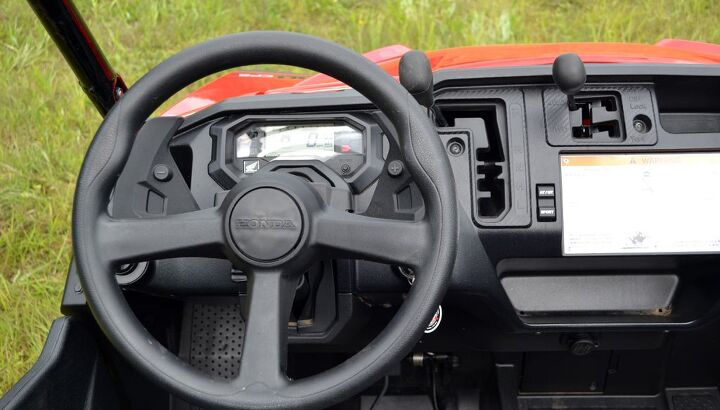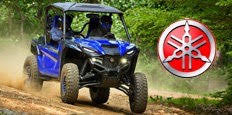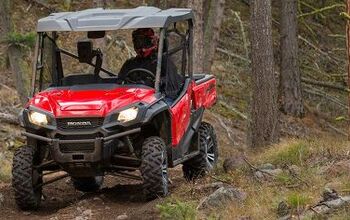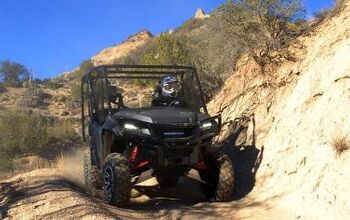2017 Honda Pioneer 1000 EPS Review + Video
MSRP: $15,399
During a recent free day in the hills of North Georgia we had the opportunity to gather our gear and take our 2017 Honda Pioneer 1000 EPS model out for one last ride. This would help confirm any suspicions and dispel any preconceived notions before we had to hand the machine back to Honda.
Knowing the Honda Pioneer as well as its roots helps us understand the type of engineering that went into the Pioneer. Our Pioneer 1000 EPS model came with a few extras over the base, including the color-matched rear fender covers and a pre-wired winch harness to make adding a winch to this machine extremely easy. You also get a tilt steering wheel and the ultimate playground bragging accessory, paddle shifters. There is also a Sport Mode shift option included, as well as a thicker, more “squishy” seat for trail comfort.
Our ride location was in the hill country of Northern Georgia and the testing for our ride would give us a very good understanding of the purpose of the Pioneer, as well as the features Honda has added to this line for all of us to enjoy. One of the goals for the testing was to simply get plenty of seat time on the trails. This is one spot where the Honda Pioneer 1000 shines. With its extreme maneuverability, as well as the powerful engine on board, we noticed several things. So here we go.
One of the very first items I try to always address is rider comfort. If you are not comfortable in the cab of a UTV you will be miserable the entire time. You may not really get a great feel for comfort at the dealer and most will not realize if they like a cab until after a few hours of good riding. Some UTV cabins are better than others, but looking directly in the eye of the Honda Pioneer it was clear that many preparations had been made for all who would sit under the steering wheel of this machine. In our opinion Honda has done a great job of not only making the driver/passenger comfortable, but also giving them a feeling of security and confidence in the cab of the machine.
In past years some people noted that the seat would get warm due to the engine being located right near the back of the seat, but we had not experienced this even in our older model Pioneer test units. Honda has added thicker seat padding, so maybe this will not only add an extra level of comfort but also dispel those heat issues some had experienced. The tilt steering on our EPS model also allowed us larger riders the comfort of situating the steering before we ride.
Ergonomically, the essential gear levers, gear selector, 2WD/4WD as well as important switches and controls have been placed well within reach. These are also easily marked for any user.
Riding in the mountains gives us not only rough, rocky hills to climb, but also tight and tree-lined paths to maneuver the Pioneer. Our Pioneer is outfitted with electronic power steering. This made the trips through the tight trees as well as the spots where the trails ended easy as those 40-point “wrong turns” were completed. We didn’t have to muscle the Pioneer, even in 4WD, and steering effort still allowed us to feel connected to the trail at speed. It has always been my personal opinion that power steering should be on every UTV that leaves the dealership, no matter the brand.
Another great feature on our particular long-term test unit was the paddle shifting capability. This comes with the EPS package, along with a few other items. This sure does make choosing a gear easy. If you happen to be in the automatic setting on the dash, yet need a lower or higher gear, you can simply request it by pulling on the lever to the left or right of the steering wheel with a single-finger movement.
Heading down some steep descents in the Pioneer 1000, we found ourselves hoping for a lower gear and the paddle shift capability made that easy. Now if you are like us and want to control the shift changes instead of allowing the machine to do so, you simply push the manual mode side of the rocker switch located on the dash. This allows you to make your own gear selection at your preferred time. This paddle shift option is also evident on the faster sections of the trail when you want to shift up before the computer thinks it need to. We noticed during really slow or creeping trails while in first gear that we preferred to be in second as soon as possible, as the engine didn’t have to rev so hard and it made the ride a tad bit more enjoyable.
All of this shifting is controlled by the Honda-exclusive DCT transmission. There are essentially two clutch packs and each controls a certain segment of gears. Each gear is pre-launched into “ready” as the other gear is being used. The clutch then allows the gears to change smoothly, similar to how your automatic transmission in the daily driver shifts. Honda has perfected not only the ability to do these shifts, but also the smoothness seems to be getting better as well. We did notice that in automatic mode the shifts seem to come a little faster than we would like at times, but simply pressing the dash-mounted sport mode rocker switch would keep the engine in a gear until it reached a higher RPM before shifting. As mentioned before, we also simply flipped the downshift paddle to get back to a gear we thought we needed.
Some of the time in our test ride was also spent with a trailer and gear loaded to the two-inch receiver. The Pioneer seemed to handle it well. There was a very slight dip in the 999cc fuel injected engine’s power or response, but the suspension as well as the attitude of the UTV never wavered.
The downhill attitude of the Honda Pioneer seemed to be very confidence-inspiring as it seemed to slow the entire load very well. Honda’s engine braking was very impressive, even with a loaded trailer.
After another full day of riding we figured out that the Honda Pioneer 1000 EPS is a very able and willing worker, as well as a smooth trail ride for the days when the work is finished.
Whether he is in Mexico covering the Baja 1000, building ATVs for local racers, or out enjoying the trails, Rick’s passion shows in his stories. Learning to wrench his own machines from his grandfather, Rick also has an undying appreciation for the mechanics of off-road vehicles. Do not let the dirt and mud fool you, though, as Rick also has a deep love for street cars.
More by Rick Sosebee

































